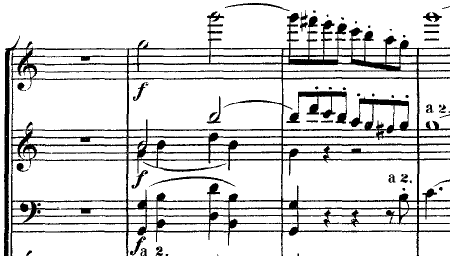I have orchestrated the exposition of Eine Kleine Nachtmusik and gotten several comments. Here I will concentrate on a single comment that I got, that the oboes are too high in bar 11. I got no suggestions as to how to fix the issue though, which I thought was just wrong, given that I had a detailed analysis of my orchestration mistakes. But I thought of a few solutions to the issue. Here is the edition of Mozart's score that I used for my orchestration:
I would use the Mozart manuscript, since it is written neatly and easily readable. But most of the Mozart manuscript isn't there, just a few pages of each movement. So the manuscript is out of the question as far as reference material goes.
And here is what the woodwinds look like in bars 10-15 of my orchestration:
The green note is just defaults from Musescore, I didn't make that note green, in case you were wondering.
Just in case you are wondering, here is my instrumentation:
- 2 Flutes
- 2 Oboes
- 2 Clarinets
- 2 Bassoons
- 2 Horns(I originally thought of having a third horn but was told that it wasn't very Mozartesque to do that, so I retracted the third horn)
- 2 Bb Trumpets(I was told that I should change this to C trumpets, but Bb is the default for the Classical Orchestra template)
- Tympani
- 1st Violins
- 2nd Violins
- Violas
- Cellos
- Double basses
Here are my proposed solutions for the woodwind issue at bar 11:
Option 1: Switch oboes and clarinets
Here, I would move the oboe part to the clarinets and likewise, I would move the clarinet part to the oboes. This would, if I'm correct on this, give a mellower sound than having the oboes up in that range. Just to make sure that I don't overwrite anything in the process of doing this in Musescore, I had the horns be silent here. Here is what it looks like after the switch:
Option 2: Oboes double clarinets, Flutes take over oboe part
Here, I would simply have the oboes doubling the clarinets. The flutes would be playing what in the previous version, I had the oboes play. Here is what it looks like after that change:
Myself, I think I prefer the oboe and clarinet switch over the doubling. I already have enough doublings between the woodwinds and the strings. I don't need more between 2 different woodwind parts. Plus, I think that upper reinforcement of the flutes is necessary. Having the flutes take over the oboe part would get rid of this upper reinforcement.
Here is what I have so far of my orchestration, so that you can listen to it. Note, that this is before any error corrections occurred.
https://musescore.com/user/50070/scores/5626150
Should I go with option 1 or option 2? Or is there something else that I missed? Note: I'm not thinking of just taking the oboe out entirely. That would be, I think, the worst option.






